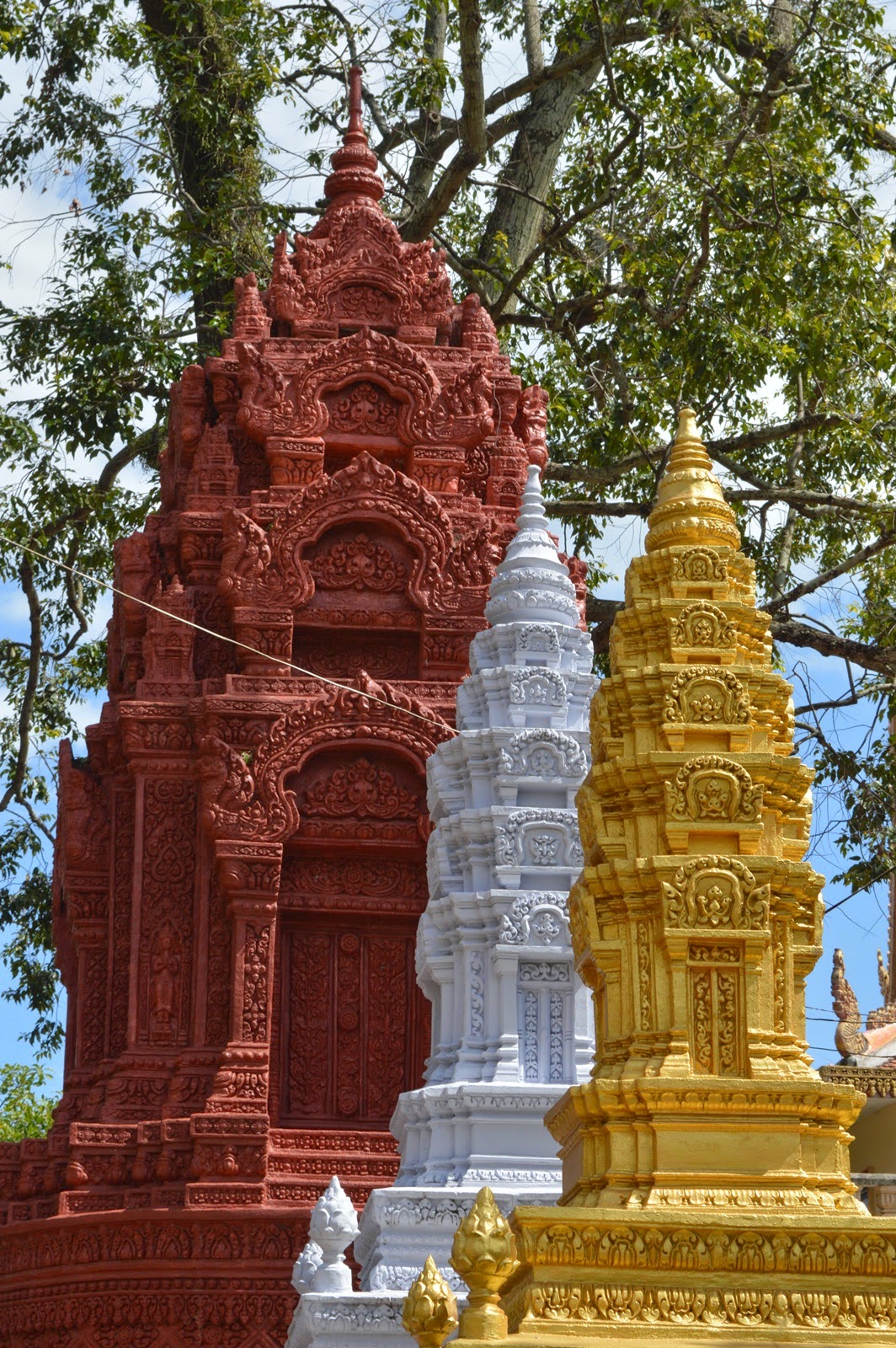Seguíamos nuestro peculiar periplo por Camboya, el siguiente destino fue Kampot, famoso en el mundo entero por sus plantaciones de pimienta.
Aquí nos encontramos con una ciudad tranquila, acogedora, con cierto aire colonial francés. Visitamos los puntos de mayor interés turístico subidos a un típico tuk tuk y aprovechamos al máximo nuestra estancia en esta ciudad.
Kampot is a bit the sleepy hollow of the south of Cambodia. It's a perfect place for long lazy afternoons, when you just want to sit in a cozy restaurant terrace sipping your fresh coconut juice (coc plantations surround Kampot ) and doing nothing. The Frenchmen left their colonial touch to the architecture- the main streets are pretty nice and bring some nostalgy to the cities center.
Outside Kampot there are huge pepper plantations- the probably best pepper in the world comes from Kampot (it really is soo good- and the pepper sauce with fresh lemon is a masterpiece!). We saw also so many green rice fields,which made such a beautiful contrast to the dark blue skay, just before the (not so heavy) rain. Also- we saw the salt evaporation ponds- but unfortunately it was not the season for salt making... still the salty desert of ponds was quite imopressive.
Szorcik: Kampot na południu Kambodży to raczej senna miejscowość, taka gdzie jedynym sensownym zajęciem wydaje się być sączenie świeżego soku z kokosa na tarasie restauracji z widokiem na rzekę (a kokosów tu nie brak- Kampot otoczone jest jego plantacjami).
Po Francuskiej epoce kolonialnej pozostało tu dość sporo budynków w centrum miasta- wszystkie one, pomalowane w różne kolory, niektóre nieco zapuszczone budzą nostalgię za dawnymi czasami.
Poza Kampot zwiedzić można plantacje najlepszego pieprzu świata- na serio jest on niesamowity, a sos z pieprzu i świeżej limonki, mimo swej prostoty, to mistrzostwo sztuki kulinarnej.
Wokół Kampot nie brak też pól ryżowych. Urzekły nas one dzięki kontrastowi, jaki tworzyła zieleń ryżu wobec ciemnego burzowego nieba (z którego nie powstała jednak zbyt wielka ulewa).
Ciekawostka były ciągnące się kilometrami stawy do pozyskiwania soli morskiej- akurat puste, gdyż epoka odparowywania soli przypada na miesiące suszy.
Aquí nos encontramos con una ciudad tranquila, acogedora, con cierto aire colonial francés. Visitamos los puntos de mayor interés turístico subidos a un típico tuk tuk y aprovechamos al máximo nuestra estancia en esta ciudad.
Kampot is a bit the sleepy hollow of the south of Cambodia. It's a perfect place for long lazy afternoons, when you just want to sit in a cozy restaurant terrace sipping your fresh coconut juice (coc plantations surround Kampot ) and doing nothing. The Frenchmen left their colonial touch to the architecture- the main streets are pretty nice and bring some nostalgy to the cities center.
Outside Kampot there are huge pepper plantations- the probably best pepper in the world comes from Kampot (it really is soo good- and the pepper sauce with fresh lemon is a masterpiece!). We saw also so many green rice fields,which made such a beautiful contrast to the dark blue skay, just before the (not so heavy) rain. Also- we saw the salt evaporation ponds- but unfortunately it was not the season for salt making... still the salty desert of ponds was quite imopressive.
Szorcik: Kampot na południu Kambodży to raczej senna miejscowość, taka gdzie jedynym sensownym zajęciem wydaje się być sączenie świeżego soku z kokosa na tarasie restauracji z widokiem na rzekę (a kokosów tu nie brak- Kampot otoczone jest jego plantacjami).
Po Francuskiej epoce kolonialnej pozostało tu dość sporo budynków w centrum miasta- wszystkie one, pomalowane w różne kolory, niektóre nieco zapuszczone budzą nostalgię za dawnymi czasami.
Poza Kampot zwiedzić można plantacje najlepszego pieprzu świata- na serio jest on niesamowity, a sos z pieprzu i świeżej limonki, mimo swej prostoty, to mistrzostwo sztuki kulinarnej.
Wokół Kampot nie brak też pól ryżowych. Urzekły nas one dzięki kontrastowi, jaki tworzyła zieleń ryżu wobec ciemnego burzowego nieba (z którego nie powstała jednak zbyt wielka ulewa).
Ciekawostka były ciągnące się kilometrami stawy do pozyskiwania soli morskiej- akurat puste, gdyż epoka odparowywania soli przypada na miesiące suszy.
















.JPG)
.JPG)
.JPG)
.JPG)
.JPG)
.JPG)
.JPG)
.JPG)
.JPG)
No hay comentarios:
Publicar un comentario